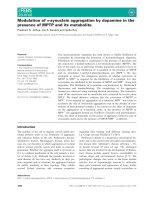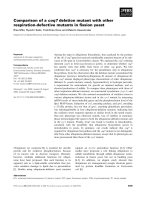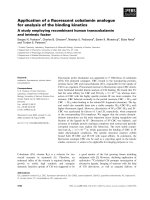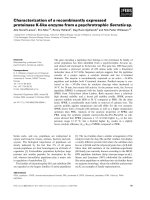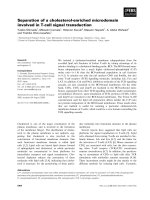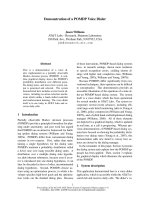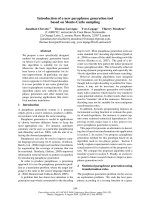Báo cáo khoa học: "Development of a new branchiness index ASIX – A simple tool to describe branchiness in young deciduous forest stand" pps
Bạn đang xem bản rút gọn của tài liệu. Xem và tải ngay bản đầy đủ của tài liệu tại đây (127.03 KB, 8 trang )
Original article
Development of a new branchiness index ASIX –
A simple tool to describe branchiness
in young deciduous forest stands
Gerhard Struck and Achim Dohrenbusch*
Institute of Silviculture, Department I: Silviculture of the Temperate Zones and Forest Ecology,
University of Göttingen, Büsgenweg 1, 37077 Göttingen, Germany
(Received 6 September 1999; accepted 24 March 2000)
Abstract – Description of young tree’s quality is difficult, in particular there is no adequate and easy applied method to describe
branchiness. The following contribution describes the development of a new index to estimate the branch’s diameter influence on
tree quality. On the base of the measurement of 2520 young oak trees (22 years old), the branchiness index, A
SIX, was created as the
ratio between the branch of the largest diameter and the tree’s diameter at breast height (DBH). The idea was that a same diameter of
branches is worse for small trees than for bigger ones. In a very wide range of plant densities, no influences of the different initial
densities on the A
SIX values were found. Trees in wider plantations with a higher branch diameter had as good ASIX-values than trees
in denser plantations with a lower branch diameter. But, however, an influence of different site conditions on the A
SIX was noticed.
A
ISX was better within better site conditions compared to worse site conditions. It is concluded that the description of branchiness
using this ratio is better than the use of absolute diameter values. A
SIX integrates the stands growth potential in terms of DBH. The
use of this index avoids the overestimation of branch-thickness for trees with a high growth potential. Due to a lack of literature
dealing with branch-ratios, there are no comparisons to other indices in the discussion.
branchiness / index / stand density / deciduous forests / quality / Quercus
Résumé – Développement d’un nouvel indice de branchaison «ASIX» : un outil simple pour décrire la branchaison dans de
jeunes peuplements de forêts décidues
. La description de la qualité de jeunes arbres est difficile, en particulier il n’existe pas de
méthode facile et adéquate pour décrire la branchaison. La contribution suivante décrit le développement d’un nouvel indice pour
estimer l’influence du diamètre des branches sur la qualité de l’arbre. Sur la base de mesures de 2520 jeunes chênes (âgés de 22 ans),
l’indice de branchaison, «ASIX», a été créé comme étant le rapport entre le diamètre de la branche la plus grosse et le diamètre à
hauteur de poitrine (DBH). L’idée est que, à diamètre identique, les arbres les plus petits sont les moins bons. La densité initiale du
peuplement n’a pas d’influence sur les valeurs calculées de l’indice ASIX. Les arbres des plantations les moins denses, avec des dia-
mètres de branches plus élevés, ont une valeur de l’indice aussi bonne que celle des plantations moins denses avec des diamètres de
branches inférieurs. Les conditions du milieu influent cependant sur la valeur de cet indice. ASIX est meilleur lorsque les conditions
stationnelles sont bonnes. On conclut que la description de la branchaison par cet indice est meilleure que l’usage de la valeur abso-
lue du diamètre. ASIX intègre le potentiel de croissance en terme de DBH. L’usage de cet indice évite les surestimations de la taille
des branches sur les arbres à fort potentiel de croissance. En raison du manque de bibliographie dans ce domaine d’indice rapport de
branche, il n’y a pas de comparaison avec d’autres indices dans la discussion.
branchaison / indice / densité du peuplement / forêts décidues / qualité / Quercus
Ann. For. Sci. 57 (2000) 811–818 811
© INRA, EDP Sciences
* Correspondence and reprints
Tel. (49) 551 39 36 78; Fax. (49) 551 39 21 70; e-mail:
G. Struck and A. Dohrenbusch
812
1. INTRODUCTION
The objective description of young tree’s quality in
deciduous forests is still difficult, in particular within
forest investigations [1, 28]. Tree quality is often esti-
mated by the use of categorical variables [6, 8, 9, 24,
28].
One main factor influencing the trees’ quality is the
diameter of branches. This feature is mainly assessed by
the measurement of absolute branch diameter [7, 10, 16,
21, 25, 26, 27]. But the comparison of absolute branch
thickness of differently treated stands does not consider
the growth potential of the trees. Harmer [14] points out
that vigorous trees often carry heavy stem branches that
reduce timber quality, whereas less vigorous trees have
smaller branches but are often of bad growth.
But does a branch of certain diameter influence the
tree quality of good and bad growing trees in the same
way? Certainly not. Due to this, there is a need of easily
to measure parameters to describe the branch-diameter
effect on tree quality under consideration of the individ-
ual growth potential.
Following the ideas of Kramer [17] and Mayer [20],
which created different crown-indices, the following arti-
cle describes the development of a branchiness index
(A
SIX) on interval scale.
This could be a method to describe the influence of
branches on tree quality under consideration of the indi-
vidual growth potential of each tree.
2. MATERIALS AND METHODS
Base of this investigation are 2520 22-year-old oaks,
which were measured on 24 experimental plots located
in the forest district Fuhrberg near Hannover [28]. This
region in north-western Germany is characterised by a
subatlantic climate with an annual precipitation of
700 mm and a mean annual temperature of 14.5 °C. The
soil is a poor sandy pleistocene podsolic cambisol
(FAO). The plots have been afforested in 1976 using
three different densities and two year old seedlings. The
oaks were 24 years old at the date of measurement. The
three different initial densities were very high compared
to actual plantation densities. The current density within
the stand is still very high and the differences between
the initial densities are also obvious (table I).
Before afforestation, the whole logging slash includ-
ing the humus layer was pushed on ramparts using bull-
dozers. Due to this practice a gradient of different nutri-
ent situations can be noticed on the plots. The growth
potential of trees was considerably higher close to the
ramparts compared to potential of plants in a greater dis-
tance [29]. This experimental design was very suitable to
investigate branchiness of young trees under different
yield situations.
To detect the effects of initial density and logging
slash removal, the following features were measured on
105 trees [28, 29, 30]:
– Tree height;
– DBH;
– Branch of the largest diameter within in the first 2.5 m
height. Branch thickness was measured, at right
angles to the branch, 2 cm apart from the stem-inser-
tion with digital slide-gauge. Living branches only
were considered.
3. RESULTS
Tree height showed a reaction to the nutrition gradi-
ent. In the “wide spaced” plantations, trees in a distance
of 12 m to the humus ramparts reached only 75% of the
height of trees directly beside the ramparts. In the “medi-
um spaced” and “narrow spaced” plantations, the height
growth decreased to about 50% compared to the trees
close to the ramparts. The rampart’s effect on the tree
height was greater, with higher plant-density (figure 1).
The DBH decreased for all initial densities, with a dis-
tance of 6 m from the rampart. As already mentioned for
height, the effect on the DBH increased with higher
plantation density. Compared to the height, DBH was
affected less.
Figure 2 furthermore shows that mean
DBH was greatest for the “wide spaced” plantation
Table I. Different initial densities of the experimental plots.
Spacing Plants per ha Current density Characterisation
1.4 m
× 0.3 m 23810 plants ha
–1
19700 plants ha
–1
“narrow spaced”
1.4 m
× 0.5 m 14826 plants ha
–1
12464 plants ha
–1
“medium spaced”
1.4 m × 0.8 m 8928 plants ha
–1
7455 plants ha
–1
“wide spaced”
ASIX – A new branch index
813
followed by the “medium” and finally the “narrow
spaced” plantation .
As a result of less competition, the growth potential of
individual trees was higher for the “wide spaced” planta-
tion.
In the “wide space” plantation, the branch thickness
was greater compared to the other densities. Branches in
the wide spaced plantations had a mean diameter of
about 1.5 cm, whereas the branch-diameter in the medi-
um spaced plantation (1.3 cm) did not differ significantly
from the narrow spaced plantation (1.2 cm).
Within the same plantation density, the branch thick-
ness was equal even in different distances to the humus
rampart. Trees with a low height and a low DBH had
Figure 1. Effect of the humus
rampart distance on the mean
height in the different initial
densities.
Figure 2. Effect of the humus
rampart distance on the mean
DBH for the different initial
densities.
G. Struck and A. Dohrenbusch
814
branches as thick as good growing trees close to the ram-
parts. Hence, the nutrition gradient seemed not to influ-
ence the branch diameter. Struck [28] showed that nei-
ther the mean branch diameters were influenced by the
rampart distance, nor the extreme values. He found as
heavy branches near the ramparts as in a distance of
more than 20 m (figure 3).
A significant correlation between branch thickness of
the biggest branch and the DBH (r = 0.5) was found. But
the value dispersion was to high to create a successful
regression between the parameters.
This result pointed out that, on the one hand, there
were small trees with comparable big branches and on
the other side large trees with comparable small
branches.
Assuming that the quality of a good growing tree, in
comparison to a bad growing tree, is affected less by a
branch of equal thickness, the growth potential has to be
integrated in the model to describe the effect of branchi-
ness on tree quality. The branchiness index (A
SIX) was
accordingly calculated for each single tree
i
as follows:
ASIX
i
=
.
The ASIX-value describes the branch thickness of a tree
as the percentage of its DBH. Using this method, the
description of branch thickness is weighted with the
growth potential. The tree’s quality decreases with an
increasing ASIX-value.
Figure 4 shows the development of the ASIX in
dependence on the ramparts distance exemplary for the
“narrow spaced” plantation.
The branches grew thicker in relation to the DBH
with a growing rampart distance. Therefore, tree quality
decreases.
If the different plantation densities were compared on
the base of the A
SIX, a different result is found compared
to the analyses of absolute branch thickness. The branch-
iness indexes of the different initial densities do not dif-
fer significantly. The distributions of the values are
almost identical as well. Merely the “wide spaced” plan-
tation shows a smaller value-dispersion.
Even, the median value shows that tree quality, mea-
sured by the ASIX value, for the “narrow spaced” plan-
tation is worse than for the other densities. This is the
result of bad DHB-growth on the “narrow spaced” plan-
tation. It is conspicuous that the wide space plantation
does not reach ASIX-values of more than 85%. Due to the
good DBH-growth the tree quality for this plantation
density is affected less by the absolute thicker branches
(figure 5).
Mean values of the whole collective are of less inter-
est for the estimation of the young stand’s quality. The
future economical value of the young stands is formed
by the future crop trees. These trees will be normally
maximumbranchdiameter
i
(cm)
×
100
DBH
i
(cm)
Figure 3. Effect of the humus
rampart distance on branch
thickness for the different initial
densities.
ASIX – A new branch index
815
selected from the 20% biggest trees of a stand. Cause our
measurement included 840 trees per different density,
the following results refer to 170 future crop trees in
each density.
It is obvious considering this collective, that the ASIX
is slightly better for the “narrow spaced” plantation com-
pared to the other densities (figure 6).
Figure 4. Effect of the nutri-
ent gradient on the develop-
ment of branchiness index
(narrow spaced plantation).
Figure 5. Box Wisker plot
for the branchiness index of
the different densities.
G. Struck and A. Dohrenbusch
816
Using this index and considering a certain value for
the ASIX, it is shown how the branch thickness could
increase without detecting a decrease in quality.
Therefore the equation for the ASIX-calculation is
changed to:
maximum branch thickness
i
(cm) =
ASIX × DBH
i
(cm)
100
If the silvicultural aim is an A
SIX of up to 50%, the
branch thickness should have been increased from
2.54 cm in the “narrow plantation” to 3.47 cm in the
“wide plantation” without any decrease in tree quality
(table II).
If the silvicultural aim is a certain maximum A
SIX, the
mean increment of branch thickness without a loss of
future tree quality, can be calculated. The ASIX is able to
quantify the influences of different densities on the
branch quality under consideration of the stand growth
potential. The results show that the calculation of the
A
SIX could be method to detect influences of thinning
age and thinning grade on tree quality. This application
of ASIX should be tested in further investigations. The
ASIX-method enables the user to note relative changes in
branch quality.
4. DISCUSSION
Unbiased estimation of quality in young deciduous
forest stands is a problem. In practice, the trees are
selected by individual preferences of foresters. But sci-
ence, as well, lacks objective and easy methods to esti-
mate tree quality. Hakkila [12] and Hakkila et al. [13]
used similar indices to ASIX to estimate branch amount
Figure 6. Box Wisker plot
for the branchiness index in
the different densities for
the 20% biggest trees.
Table II. Calculation of branch thickness with a special Asix.
Initial spacing Silvicultural desired DBH 20% Calculated branch
Asix biggest trees thickness
“narrow spaced” 50 5.09 cm 2.54 cm
“medium spaced” 50 5.81 cm 2.91 cm
“wide spaced” 50 6.97 cm 3.48 cm
ASIX – A new branch index
817
as a raw material source. But we found no similar quo-
tients to ASIX with the aim to describe tree quality.
Categorical variables have been mainly used
[1, 7, 9,
28]. Hence, the comparison of different investigations
using categorical features is difficult, because the estima-
tion depends on subjective impressions [9]. The results
differ from person to person even if the same stands are
surveyed. These kind of disadvantages caused by using
categorical variables can be avoided by the use of fea-
tures on interval scales. These interval scale variables
must be created so that the results are independent from
the measuring person. For this reason, forest scientists
prefer the comparison of absolute branch thickness. The
disadvantage of this method is that the different yield
potentials of the stands cannot be considered.
It is pointed out in many investigations, that trees,
which grew in “wide spaced” plantations are of worse
quality than trees growing in dense stands, because
branch thickness increases with an increase in individual
space [7, 10, 16, 21, 24, 25, 26, 27, 28]. The current
investigation showed the same results:
The oaks’ branches were thicker with decreasing ini-
tial density but not thicker with worse site conditions
[28, 29, 30]. The site gradient effects are discussed by
Struck [28]. He did not find any influences on branch
architecture. Large branches were found in each different
distance to the humus ramparts.
However, it should be considered that plants having
more space to grow have better DBH growth
[2, 10, 11,
17, 24, 26].
The rare at which branches are occluded is also
important in determining wood quality. In most cases,
branches will be overgrown faster in wide space planta-
tions. Niemisto [23] reports that the self–pruning process
of dead branches may be slowed down in very dense
stands. Becker et al. [2] point out that thicker branches
have no influences on the quality, if these branches
would be overgrown faster, and the better youth growth
leads to the development of relatively fine wood.
Grünebaum et al. [11] investigated oaks from a wide
space plantation and noticed that the faster youth growth
did not lead to worse inner wood quality. It is therefore
clear that an analysis of the absolute branch thickness,
only, in differently treated stands is not enough to esti-
mate their future quality. Scientists do not know which
supposed tree defects will disappear in the stand’s future
life. The estimation of branchiness and its effect in later
ages is difficult.
In the literature one can find a large amount of models
dealing with branchiness (for example, [3, 4, 5, 14, 18,
19, 22]). Mainly, the intention of such investigations is
the prediction of the development of architecture under
different silvicultural systems and they deal with conifer-
ous species. The development of A
SIX had not the aim
to create another architectural model. The ASIX values
are proposed as an additional, very easy, tool to describe
and compare tree quality. The periodical comparison of
the A
SIX-values is able to detect the influences of differ-
ent silvicultural treatments on the branch quality. It is
clear, that the diameter of the largest branch is not the
only factor responsible for the future value of a tree.
Amount of branches on the trunk is also very important.
It is possible to create other indices on the base of
A
SIX to avoid these problems: For example, it is possible
not only to use the diameter of the largest branch but
also to calculate a mean value of several branches. It is
furthermore conceivable to weigh the A
SIX-value with
the number of branches on a special bole length. A tree
with a high number of little branches does therefore not
automatically have a better quality than a tree with only
one or two big branches. The emphasis on a certain bole
length further integrates the fact that branches in a spe-
cial insertion height (for example more than 10 m) did
not influence the quality at all.
The A
SIX is only an attempt to define a value, which
allows an objective estimation of quality in young decid-
uous stands. Naturally, appearing branches and their
thickness are an important quality defect if the trees
should be sold. The estimation of tree quality using the
A
SIX in old forests is less successful because branches on
trunks to be sold are always defects and independent
from the trees DBH. The use of the A
SIX should be con-
centrated on young stands up to polewood age. The
expected branch-free bole length should be reached at
this age and the stem defects of the young stands should
be obscured by growth, in particular for the crop trees. In
most cases, silvicultural goal is a certain branch free bole
length. Branches inserting higher than this length are of
less interest. Trees with a good growth potential should
reach this silvicultural aim in a shorter time, even if the
branches grew thicker. Asix-values may help to avoid
the overestimation of branchiness for the future quality
development, because this index integrates the growth
potential.
The A
SIX is not able to compensate the measurement
of branch diameters, but the comparison of differently
treated stands is easier using this method. It is very
important that quality described by the A
SIX is not only a
value for absolute branch diameters but considers the
individual tree growth potential.
G. Struck and A. Dohrenbusch
818
REFERENCES
[1] Anonymus, Begründung von Eichenbeständen durch
Nesterpflanzung. Procceding of a meeting with the aim to
equalize the investigation parameters in young oak high
forests. Lower Saxony Forest Research Station, Göttingen,
unpublished, 1995.
[2] Becker G., Hapla F., Teutenberg A., Untersuchungen
der Holzqualität von Traubeneichen aus unterschiedlich dicht
begründeten Beständen, Holz als Roh- und Werkstoff 48
(1990) 339–343.
[3] Bertram J.E.A., Size dependant differential scaling in
branches: the mechanical design of trees revisited, Trees 4
(1989) 241–253.
[4] Brown A.G., Doran J.C., Variation in growth and
branching characters of Pinus attenuata, Silvae Genet. 34
(1985), 100–104.
[5] Colin F., Houllier F., Branchiness of Norway spruce in
north-eastern France: modelling the vertical trends in maxi-
mum nodal branch size, Ann. Sci. For. 48 (1991) 679–693.
[6] Dippel M., Wuchsleistung und Konkurrenz von
Buchen/Lärchen-Mischbeständen im südniedersächsischen
Bergland, Diss. Forstwiss. Fachb. Univ. Göttingen, 1989.
[7] Erteld W., Verbandweite, Jahrringbreite und Aststärke
der Kiefer auf einem mittleren terrestrischen Standort im
Altpleistozän, Soz. Forstw. 28 (1978) 242–245.
[8] Fischer H., Acker- Erstaufforstungen – Bestandes-
begründung, Wachstum und Ökologie an Fallbeispielen,
Hainholz Verlag, Göttingen, 1998.
[9] Gadow K.V., Zur Bestandesbeschreibung in des
Forsteinrichtung, Forst und Holz 48 (1993) 602–606.
[10] Gaul H.T., Stüber V., Der Eichen-Nelder-
Verbandsversuch Göhrde, Forst und Holz 51 (1996) 70–75.
[11] Grünebaum M., Teutenberg-Raupach A., Paul C., Ein
Weitverband bei Traubeneiche – Auswirkungen auf
Wachstum, Schnittholzqualität und Furniereignungen, Forst
und Holz 48 (1993) 3–7.
[12] Hakkila P., Coniferus branches as a raw material
source, Communicationes Institute Forestalis Fenniae 75
(1971) 1.
[13] Hakkila P., Laasasenaho J., Kariottinen J., Branch data
for logging work, Instituti Forestale Fenniae, Helsinke, Folia
Forestalia 147 (1972).
[14] Harmer R., Relationship between Shoot Length, Bud
Number and Branch Production in
Quercus petraea (Matt.)
Liebl., Forestry 65 (1992) 61–72.
[15] Inglis C.S., Cleland M.R., Predicting final branch size
in thinned radiata pine stands, FRI-Bulletin, Forest Research
Institute, New Zealand 3 (1982) 17.
[16] Kenk G., Auswirkungen von Douglasien-
Pflanzverbänden auf Aststärken und Vornutzung sowie Über-
legungen zur Ästungshöhe, Allg. Forst- und Jagdztg. 152
(1981) 168–180.
[17] Kramer H., Waldwachstumslehre, Verlag Paul Parey,
Hamburg und Berlin, 1988.
[18] Mäkinen H., Colin F., Predicting branch angle and
branch diameter of Scots pine from usual tree measurements
and stand structural inforamtion, Can. J. For. Res. 28 (1998)
1686–1696.
[19] Matziris D.I., Variation in Growth and Branching
Characters in black Pline (Pinus nigra Arnold) of
Peleponneesos, Silvae Genet. 38 (1989) 77–81.
[20] Mayer R., Kronengröße und Zuwachsleistung der
Traubeneiche auf süddeutschen Standorten, Allg. Forst- und
Jagdztg. (1958) 105-114, 151-163, 191–201.
[21] Melzer E.W., Brunn E., Netzker D., Pflanzverband
und Kulturqualität bei Kiefer, Forstarchiv 63 (1992) 136–142
[22] Meredieu C., Colin F., Hervé J-C., Modelling branchi-
ness of Cosican pine with mixed-effect models (
Pinus nigra
Arnold ssp. laricio (Poiret) Maire), Ann. Sci. For. 55 (1998)
359–374.
[23] Niemisto P., Influence of initial spacing and row to row
distance on the crown and branch properties and taper of silver
birch (Betula pendula), Scan. J. For. Res. 10 (1995) 235–244.
[24] Schaper C., Das Jungendwachstum von Stiel- und
Traubeneichen auf norddeutschen Standorten, Diss. Forstwiss.
Fachb. Univ. Göttingen, 1978.
[25] Schmaltz J., Aststärkenentwicklung und Schaftqualität
in zwei Kiefernverbands-versuchen, AFZ 44 (1989)
1337–1339.
[26] Schmaltz J., Fröhlich A., Gebhardt M., Die
Qualitätsentwicklung in jungen Traubeneichenbeständen im
Hessischen Spessart, Forstarchiv (1997) 3–10.
[27] Spellmann H., Baderschneider A., Erste Auswertung
eines Traubeneichen-Pflanzverbands- und Sortimentsversuches
im Forstamt Hardegsen/Solling, Forst und Holz 43 (1988)
447–450.
[28] Struck G., Effekte von Pflanzverband, Kulturdüngung
und Schlagräumung am Beispiel junger Traubeneichen-
bestände, Hainholz-Verlag, Göttingen, 1999.
[29] Struck G., Dohrenbusch A., Long term effects of radi-
cal removal of logging slash on the growth and quality of
young Sessile Oak stands (
Quercus petraea Lieth), in: IUFRO-
proceedings: Advances in research in intermediate Oak stands.
Institut für Wald wachstum der Univ. Freiburg, 1997, pp.
184–192.
[30] Struck G., Dohrenbusch A., Wirkungen von
Pflanzverband und Düngung in jungen Traubeneichen-
beständen, AFZ (1998) 772–775.
